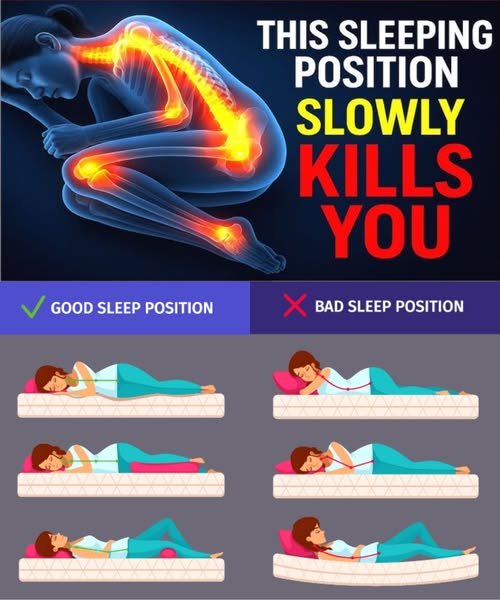Introduction

We spend one-third of our lives sleeping, yet most of us never stop to think about how our sleeping position affects our health. While sleep is meant to restore and rejuvenate, the wrong posture can silently wreak havoc on your body. From back pain and poor circulation to heart strain and even breathing problems, the way you sleep could be doing more harm than good.
The truth is, not all sleeping positions are created equal. In fact, research shows that certain positions can lead to long-term health complications if practiced consistently. This article will reveal the most dangerous sleeping position, explain why it’s harmful, and provide science-backed solutions to protect your health while still getting quality rest.
By the end of this blog, you’ll not only know what to avoid but also how to adopt healthier sleep habits that improve your overall well-being.
What Is the Most Dangerous Sleeping Position?
The stomach sleeping position (prone position) is widely considered the most dangerous for your health. Although some people find it comfortable, doctors and sleep specialists warn that it can cause a range of problems, especially when practiced long-term.
Why Sleeping on Your Stomach Is Dangerous:
- Neck Strain – To breathe while lying on your stomach, you have to turn your head to one side, which puts unnatural pressure on the cervical spine. Over time, this can lead to chronic neck pain and stiffness.
- Spinal Misalignment – The natural curve of the spine is compromised when lying face down, leading to lower back pain and long-term posture issues.
- Nerve Compression – Stomach sleepers often tuck their arms under their pillow, which can compress nerves, causing tingling, numbness, and even long-term nerve damage.
- Restricted Breathing – This position can put pressure on your lungs and diaphragm, making it harder to take deep, restorative breaths while you sleep.
- Increased Risk in Pregnancy – For pregnant women, stomach sleeping can restrict blood flow to the baby and increase the risk of complications.
According to the American Sleep Association, only 7% of people sleep on their stomachs, but this small group is at significantly higher risk for musculoskeletal problems compared to back or side sleepers.
The Hidden Dangers: What Science Says
- A study published in the Journal of Physical Therapy Science found that stomach sleepers reported more spinal pain than those who slept on their backs or sides.
- Research in the Journal of Applied Physiology revealed that restricted breathing during sleep reduces oxygen intake, which can contribute to fatigue and poor cognitive function.
- Chiropractors frequently warn that stomach sleeping leads to long-term posture problems, as the spine is forced into an unnatural position for hours at a time.
Simply put, stomach sleeping might feel cozy, but your body pays the price silently over time.
Frequently Asked Questions (FAQs) About Sleeping Positions
1. Is sleeping on your stomach ever good for you?
While it can reduce snoring and sleep apnea symptoms in some cases, the long-term risks—neck pain, back issues, and poor breathing—outweigh the benefits.
2. What is the healthiest sleeping position?
Experts recommend sleeping on your back with a pillow under your knees to maintain spinal alignment, or sleeping on your side, especially the left side, which improves digestion, circulation, and heart health.
3. Can stomach sleeping cause wrinkles?
Yes. Pressing your face into the pillow every night accelerates the formation of facial wrinkles and even contributes to skin sagging over time.
4. How do I stop sleeping on my stomach?
- Use a body pillow to prevent rolling over.
- Place a pillow under your pelvis to reduce spinal pressure if you must sleep face down.
- Train your body gradually by starting in a side or back position and using cushions to stay in place.
5. Does sleeping position affect the brain?
Yes. According to a study published in The Journal of Neuroscience, side sleeping may help the brain clear waste more efficiently, reducing the risk of neurological diseases like Alzheimer’s.
How Sleeping on Your Back Helps Your Health
Sleeping on your back (supine position) is considered the best sleeping position for overall health. Here’s why:
- Supports spinal alignment – Keeps the head, neck, and spine in a neutral position.
- Reduces acid reflux – Elevating your head slightly can prevent stomach acid from rising.
- Prevents wrinkles – No constant facial pressure against pillows.
- Protects joints and nerves – Less pressure on arms, shoulders, and hips.
However, back sleeping is not ideal for everyone. People with sleep apnea or chronic snoring may find it worsens their condition.
Why Side Sleeping May Be the Best Alternative
If back sleeping isn’t for you, side sleeping—especially on the left side—offers several proven health benefits:
- Improved digestion – The stomach and pancreas hang naturally, improving digestion and reducing acid reflux.
- Better heart function – Blood flow improves, especially during pregnancy.
- Brain detoxification – Studies suggest side sleeping may help the brain remove toxins more effectively.
- Reduced snoring – Keeps the airways open, reducing sleep apnea symptoms.
The downside? Side sleepers may develop shoulder pain or numb arms if they don’t use the right pillow support.
Tips to Improve Your Sleeping Position
Making the switch from stomach sleeping to healthier positions may feel challenging, but it’s possible with small adjustments.
1. Invest in the Right Pillow
- Use a memory foam pillow or orthopedic pillow that supports the neck and keeps the spine aligned.
- Side sleepers should use a thicker pillow, while back sleepers need a medium-loft pillow.
2. Use a Body Pillow
A long pillow placed along your body prevents rolling onto your stomach and supports the hips and shoulders.
3. Adjust Mattress Firmness
A medium-firm mattress is generally best for spinal health, offering both comfort and support.
4. Train Your Body Gradually
Try starting the night on your side or back and use cushions around you to minimize rolling. Over time, your body will adapt.
5. Focus on Sleep Hygiene
- Keep your bedroom cool and dark.
- Stick to a regular sleep schedule.
- Avoid screens before bed.
Good sleep habits make it easier to maintain healthier positions.
Storytelling Insight: A Real-Life Case
Consider Sarah, a 35-year-old office worker who had been sleeping on her stomach since childhood. She often woke up with stiff neck pain and migraines, dismissing it as stress. After consulting a chiropractor, she was advised to switch to side sleeping with a supportive pillow. Within just three weeks, her headaches reduced significantly, and she reported feeling more energized and less fatigued.
Her story is a reminder that small changes in your sleep posture can have life-changing effects.
The Bottom Line
The way you sleep matters more than you think. Stomach sleeping, the most dangerous sleeping position, silently damages your health, causing spinal issues, neck pain, restricted breathing, and even premature wrinkles.
If you’ve been sleeping this way for years, it’s not too late to change. By switching to back or side sleeping and adopting the right supportive tools—pillows, mattresses, and positioning—you can protect your body, improve your sleep quality, and prevent long-term health complications.
Your body deserves rest, not strain. So tonight, take a moment to think about how you’re sleeping—because the right position could be the key to unlocking better health, energy, and longevity.


